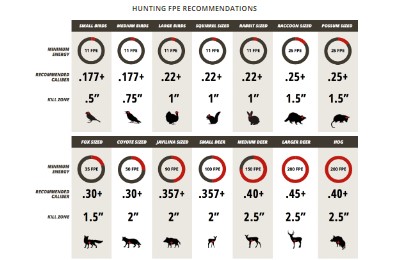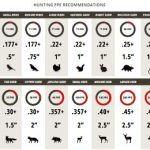Did you see that new airgun that’s shooting 1500 FPS!? A bigger number means better, right? Maybe not. While manufacturers place a lot of stock in high FPS numbers, that’s not the measure of an effective hunting airgun. Velocity without energy is pointless. How can you determine what will be a good airgun for hunting based on muzzle energy? Well, that’s exactly what we are going to talk about in this article. Let’s get started.

It’s about FPE not FPS
If you’re a regular here and have followed our posts for a while, then you’ll know that we call this issue out often. Bigger numbers are impressive. Claiming an airgun can shoot 1500 FPS is going to get people’s attention. But, not disclosing how that 1500 FPS is regularly achieved makes the claim equivalent to airgun marketing “clickbait.” We need to be focusing on FPE (foot pound of energy) over FPS (feet per second.)
FPE takes velocity along with the weight of the projectile and provides a far more objective look at things. We were testing an airgun recently for an upcoming Definitive Guide and found that while the FPS would change as much as 200 FPS, the energy (the FPE) stayed relatively consistent. That’s because airguns have a fixed “charge” regardless of the pellet or slug you are firing. Now we realize that some airguns have adjustable power. Still, as long as you leave the settings alone, the FPE should stay relatively consistent even though the velocity may change considerably.
It would be ideal if manufacturers put both FPS and FPE on the box and, better yet, if the products consistently hit those targets. Some manufacturers and products do better than others, and we hope that the trend of listing FPE alongside FPS continues to grow. The recently released Crosman Prospect is a good example, as Crosman listed references to both FPS and FPE on the box, and the Prospect comfortably hit those targets. It was very refreshing to see a product where a consumer could simply read the box and have a good idea of its performance without having to spend hours looking up reviews.
Why is FPE so Important
Now that we’ve explained the difference between FPS and FPE let’s look at why FPE is so important. Energy on target plays a major part in whether your hunting shot results in a clean, ethical kill or just a wounded animal left to die a slow death out in the woods. Additionally, having an accurate idea of an airgun’s FPE will help hunters know if a particular airgun is suitable for the task.
“What Can I Kill with My Airgun?”
What game is acceptable to hunt with a given airgun? This topic is hotly contested and we are going to fall on the conservative side of things. But since so many folks ask the question, here are some simple guidelines for you to consider. But before we throw out some numbers, be sure to check your local rules from your fish and game department. They are the folks that you’ll be answering to if you get it wrong. Make sure you do your homework before you head out into the woods and start taking shots.
Here are some basic guidelines:
- Small game – minimum 12 foot pounds – Small game would be squirrel, rabbit, and other small fur-bearing animals.
- Medium Game – minimum 30 foot pounds – Medium game would be possum, raccoon, armadillo, woodchucks, and similarly sized game.
- Predators – minimum 120 foot pounds – Predators would be coyote, bobcat, etc.
- Large Game – minimum 450 foot pounds – Large game would be deer, hogs, etc.
A less powerful airgun in the hands of an experienced airgun hunter can certainly be very effective, even on large game. So, these suggestions are not set in stone, but they are a good starting point when you are considering muzzle energy and what’s suitable for your airgun. There are going to be exceptions on both ends of the discussion. It’s up to you to know your limitations and make allowances based on your ability to make the necessary shot.
What About Energy at Range?
So far we’ve talked about FPE as related to muzzle energy. That’s how much energy your airgun is producing right as the pellet comes out of the barrel. What’s more important is how much energy you’re putting on target down range. Tools like the True Ballistics chronograph make easy work of this as it calculates FPS and FPE out to 100 yards and beyond. It can even determine the ballistic coefficient of any projectile, which is required to calculate energy at range.
Knowing the FPE at range is actually more important than muzzle energy. You may have 50 FPE at the muzzle, but that may drop to 30 FPE at 100 yards, depending on the pellet or slug. Pellets tend to shed velocity and energy more quickly than slugs, so if you are shooting 100+ yards, then finding a suitable airgun that handles slugs may be more important than something that punches paper accurately at 50 yards with pellets. The more you know about your game, your shooting conditions, and your gear, the more successful you’ll be out in the field. So go on out and do some shooting.
That’s a Wrap
Hopefully, you know a bit more about FPS and FPE. As we mentioned earlier in this article, it’s a hotly contested topic but a critical one to get right. If you have questions and want some help getting the right gear with the right energy for your next hunting adventure, please give us a call. We are always happy to help.
